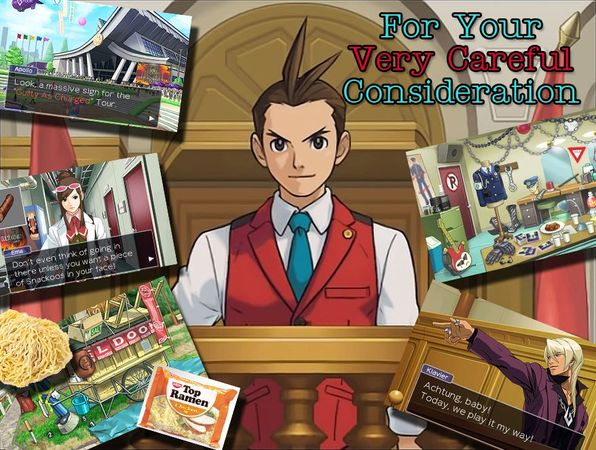
Localizing Across Cultures with Context — For Your Very Careful Consideration
Nov 11, 2017 // Janet Hsu
Hello again! This is Janet Hsu, back with another blog! Now, I know I talked before about Trucy’s Magic Panties , and also mentioned that Klavier is not actually German , but today I’d like to share with you a little more about the thought processes that went into the localization choices we made when creating Apollo Justice: Ace Attorney. So, without further ado, let’s get started!
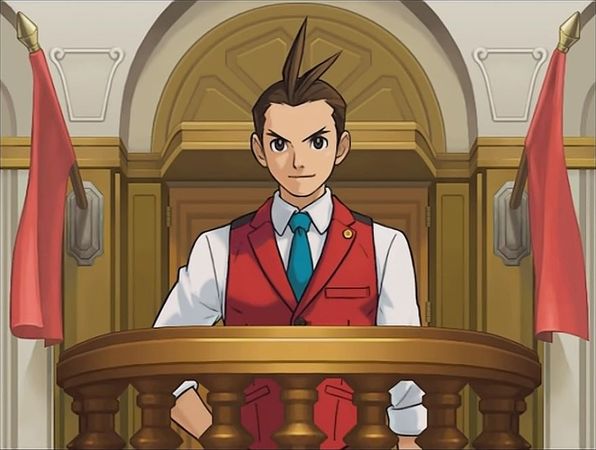
– Apollo’s first name was chosen as a way to rival Phoenix’s name. Seeing as a phoenix is a famous mythical creature with a strong presence, we felt that Apollo’s name had to be something equally as powerful. Among the other names we had initially considered were Arthur (for the King Arthur connection) and Justin (a play on “justice”).
As for his last name, “Justice” was actually at the top of the list, but two of the other names we initially threw around were Swift (like the bird, and also to imply that justice is swift) and Startel (as a parallel to his Japanese name, which phonetically sounds the same as the word for “surprise”).
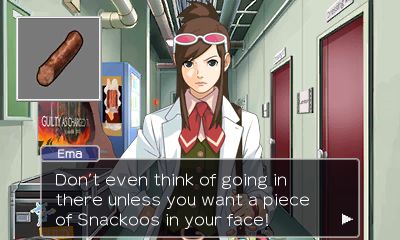
– Ema’s favorite snacks were originally translated simply as “chips,” but when I went to discuss how we were going to localize the graphics for them with the dev team, it turned out that they wanted to keep the snack’s original shape and color for the localized version, too. (I had originally suggested making them orange like cheese curls, since most American snacks of that shape are some shade of neon orange, not brown.) So, I decided it would be better to change the name of the snacks themselves and explain how the product tastes throughout the game instead. Thus, the “Snackoos” brand of chocolate snacks was born. In the Japanese version, they are a ubiquitous snack food known as karintou.
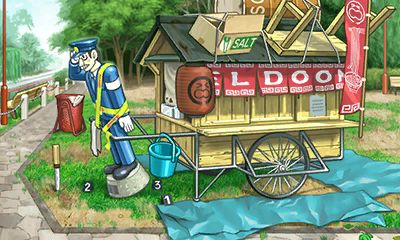
– The localization of the Eldoon’s Noodle cart was a little difficult to pull off back in the DS version because the curtain that spelled out “Eldoon’s Noodles” around the cart has 6 panels on each side, while the Japanese version ã‚„ãŸã¶ãã‚„ (Yatabukiya) only had 5. Unlike other pieces of evidence up until then, we couldn’t simply redraw the background and consider the job done. We had to re-make that part of the model for the piece of evidence you pick up, which was no easy task back in the day. In fact, there was some debate as to whether Eldoon’s Noodle should be named Nemar’s Ramen instead in order to preserve the 5 letters limit, which brings me to my next point.
If you take a look at the vertical flag on the right-hand side of the background, there’s a picture of Mr. Salty slurping up some salty noodles on it. In the Japanese version, the Japanese characters for ramen (ラーメン) were simply written vertically on it, but for the sake of the localization, we had to consider a couple of factors before we could decide on the final design.
The first consideration was how well known ramen was back in the day. Remember, this was 10 years ago (for context, check out this article ), and while you may think everyone knows what a proper bowl of ramen is now, this is what people thought of when you said “ramen” back then:
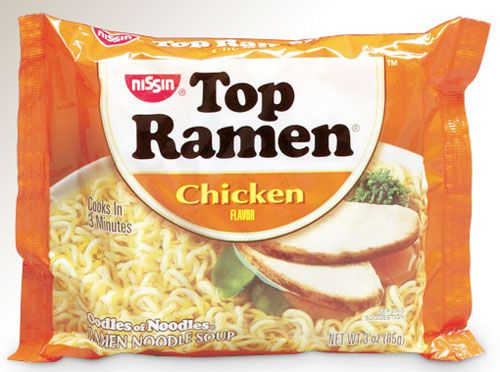
Ah, college, when 10 cents was all you needed for a meal.
As opposed to actual, fresh ramen noodles like these:

Ah, real life, where 10 dollars will barely get you a meal.
And since in the game, we didn’t actually show what a bowl of salty noodles looked like, we didn’t want to give people the wrong impression that it was some super low-class junk food when it was actually supposed to be a rich soup noodle. (True story: when I first moved to Japan in 2002, I couldn’t believe how different real ramen was from what I had eaten in America. The biggest differences were of course the broth, but also the quality of the noodles themselves. It was like eating Italian pasta — they had chew! And elasticity! And flavor! It absolutely blew my naïve little mind.)
The second consideration was how quickly a player could identify what this thing on wheels was. To a Japanese player, this cart’s design is instantly recognizable since the vertical flag clearly says “ramen” on it, and because the cart is something a Japanese person would have seen before in their everyday life. There would be no need to explain what it is, which is why there was no place built into the story to really explain anything so basic about it. However, for the localized version, we thought that it was going to be a little bit tougher for the average player to recognize what it is since not even gourmet food trucks as we know them today existed back in 2007! (They mostly started springing up in 2008 and beyond.) Had there been food trucks, then it might have been slightly easier for players to make the jump on their own.
The third consideration was whether what we went with would affect the gameplay and / or the story. If you’ve played Apollo Justice: Ace Attorney before, then you probably know what I’m talking about here….
So, between these three major factors, we decided that it would be best to convey what this stand was all about through clear iconography instead of simply writing “Ramen” or “Noodles” on the flag vertically, and to name the cart’s dear owner “Guy Eldoon.”
– Speaking of graphical changes, in resizing the graphics, I had to make a number of additional localization changes to the backgrounds in order to bring them in line with the translated text.

A lot of the things that were touched up were tiny little things that you may not even notice, but it was important to me that if you looked really carefully, you would see that things like the name of the Gavinner’s tour on the billboard matched with what the in-game characters say it says.

Another example of something that wasn’t quite so visible in the Nintendo DS version that became more visible is the bowl sitting in the middle of this table. In the original Japanese, it was a pork cutlet bowl, or katsudon as any fan of “ Yuri!!! on Ice ” will tell you, but the English had been translated as a bowl of stew, so I asked the team to make this look more like a bowl of stew instead.
The reason as to why it’s a pork cutlet bowl to begin with in the Japanese version has to do with Japanese pop culture. As it says in the Wikipedia article:
“[Katsudon] is also a famous gag of Japanese police films: many people think that suspects will speak the truth with tears when they have eaten katsudon and are asked, ’Did you ever think about how your mother feels about this?’ Even nowadays, the gag of ’We must eat katsudon while interrogating’ is popular in Japanese films.”
I’ll leave you to play the game yourself to see how this is riffed on in-game!
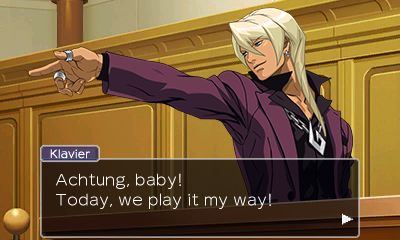
– Finally, as for prosecutor Klavier Gavin and his German lingo, there were definitely a few considerations we had to take into account when deciding his “character voice”.
The first thing was the fact that he tended to use English words in his lines. For example, the Japanese line of the screenshot above has him literally saying the English word “okay” (オーケイï¼ã€€ä»Šæ—¥ã¯ã€ã“ã‚“ãªæ„Ÿã˜ã§è¡Œã£ã¦ã¿ã‚ˆã†ã‹ï¼). This is a pretty common thing that people do in the Japanese entertainment industry, and pretty much Japanese society at large. Similar to how English speakers think that Japanese kanji are cool (to the point that some people get kanji tattoos), Japanese people find that foreign languages like English and French look and sound cool to their eyes and ears, which leads to a lot of English text only existing on a product to serve as “decorative lettering”.
This is why every time I see English text in a game I’m working on, I always ask myself: What purpose does this English text serve in the Japanese version? If the text is simply “decorative” then the words that were chosen are usually words that Japanese people simply find cool but that don’t have a whole lot of deeper meaning to them. If the English is meant to show some degree of “foreignness,” the words that were used will tend to be simple ones that any Japanese player will understand, regardless of whether or not the text sounds natural to a native English speaker. That’s why you see so many instances of what may seem to be perfectly “acceptable” yet “simple” English get changed into something more suitable for the intended audience when it is localized.
In Klavier’s case, his Japanese characterization is molded after a traditional J-rocker archetype, and as such, his speech is peppered with random English words and phrases as a way to elevate his coolness factor. This meant that in trying to come up with something that would convey a similar feel, we had to make him sound cool with a hint of foreignness in the English version. The answer we came up with was German rock. Bands like Rammstein and Tokio Hotel were in during the late ‘90s and early ‘00s, and the German rock scene was very active and producing all sorts of new genres at this time. It’s not too much of a stretch to think that just maybe Klavier was inspired by these amazing bands of the era.
———————–
There are so many other stories I want to share, but I’m afraid a lot of them would get super spoilertastic, so I’ll have to leave it here for today. But I hope this has given you a little more insight into how much thought goes into each localization decision, big or small.
Next week, I’ll be back with more stories, this time from the dev team! If we’re lucky and Mr. Takumi has the time, we might even get to hear some stories straight from the scenario writer’s mouth!
Until then!
Catch up on previous blog entries here!
-
Brands:Tags:
-

Loading...
Platforms:
